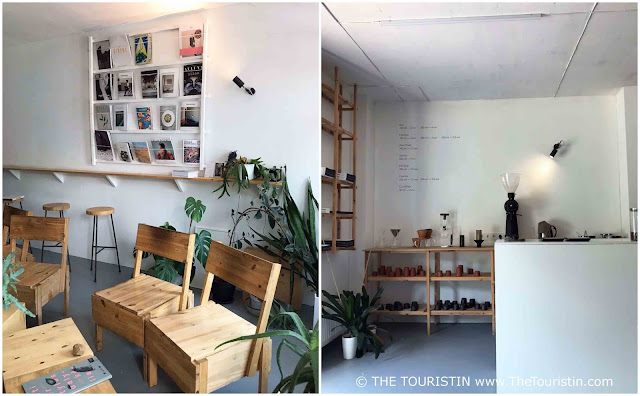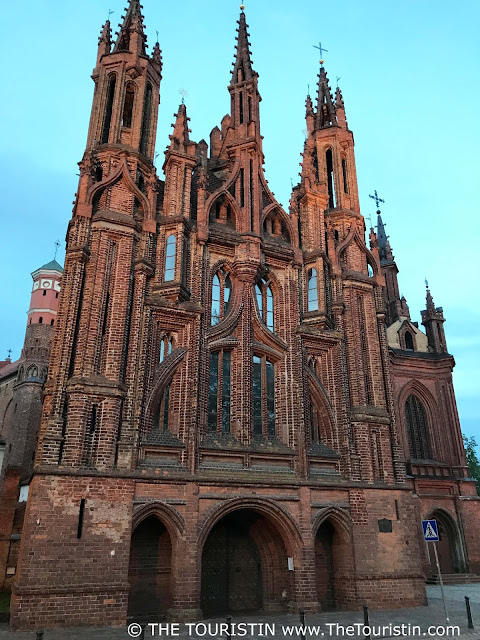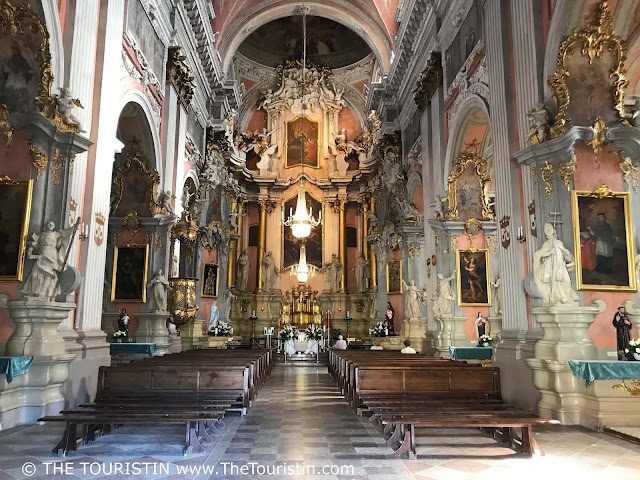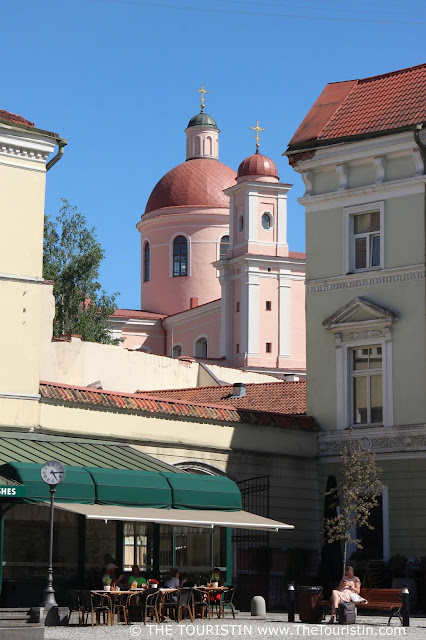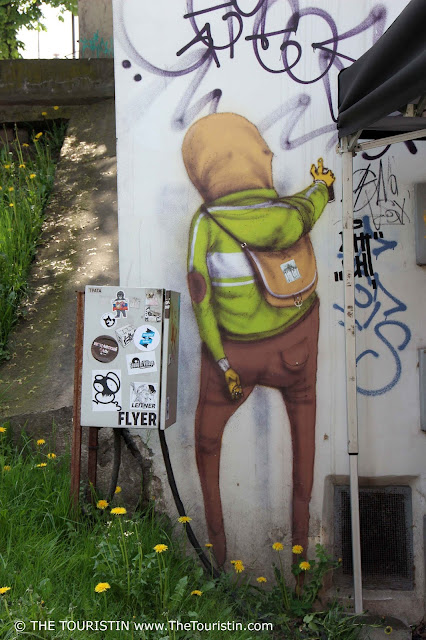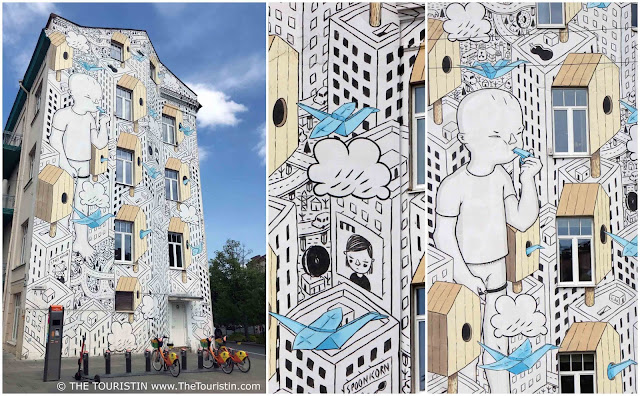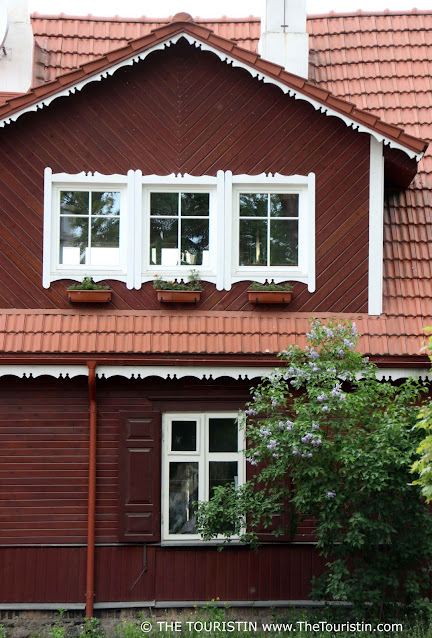Vilnius is a sociable and friendly town. In summer, there are street buskers in many places; this is a big change to what used to be when artists had a hard life under Soviet rule. The official language is Lithuanian, whereas Russian, Polish, Belarusian, and Ukrainian are often spoken too. The old town is brimming with buildings in Gothic, Renaissance, Baroque and Classical styles. Vilnius is a place to visit for all fans of architecture and history, as well as for all the ones interested in art and food.
The
capital in the southeast of Lithuania, is only 40 kilometres from the
border post to Belarus, is small enough to walk everywhere. The more you
walk, the better you experience the fusion of influences from the West
and the East. Read the Vilnius for First Time Visitors Guide to find
speciality coffee shops, vegetarian-friendly restaurants, contemporary
art, stellar architecture, exotic churches, colourful street art,
open-air and covered food markets, a hotel for art lovers, an
independent republic which explains why everyone is responsible for
their freedom, plus information about Visa requirements, travel weather,
currency and languages.
It all started with the building of a wooden castle around 1000 AD. From then on, there was only one way for Vilnius, forward. In 1323 Vilnius was the capital of the Grand Duchy of Lithuania. Soon after, in the 15th century, Vilnius was the capital of a country that had grown to become the largest country in Europe, stretching from the Baltic Sea in the North to the Black Sea in the South. Today Lithuania shares borders with Latvia, Belarus, Kaliningrad, and Poland. The stretch between Kaliningrad and Latvia is the coastline on the Baltic Sea.
Vilnius great coat of arms carries the motto "Unitas – Justitia – Spes," which in English is "Unity – Justice – Hope". Understandably. The country went through most turbulent and horrible times before it became a member state of the EU in 2004. Occupied by Russia in 1795 and controlled by Germany during World War II. After WW2, from 1944 until its independence in 1990-1991, Lithuania was under Soviet rule. The old town of Vilnius became a UNESCO World Heritage site (soon after independence) in 1994.
Coffee? Where to Drink Speciality Coffee aka Third Wave Coffee in Vilnius
There is no shortage of cafes in Vilnius, but I search for Speciality coffee shops, aka Third Wave coffee shops. At Speciality coffee shops they care about a high-quality of the beans (probably the secret to great tasting coffee), they care about the working conditions of farmers, and they care about the roasting, grinding and brewing process.
Crooked Nose and Coffee Stories. Emanuelis Ryklys, the owner of Crooked Nose and Coffee Stories, celebrates the speciality coffee culture. He tells me that he "organizes coffee tastings" and "loves to educate as many people as possible about great coffee". This is a true Slow Coffee Bar, where the coffee is brewed manually by hand. Smell and choose the beans (let’s say the ones from Rwanda, Yemen or Colombia), choose the coffee maker (Chemex or Aeropress) and enjoy life. The choice of magazines is just as impressive as the concept of a freshly brewed coffee bar. This is only a few moments’ walk from MO Museum. Crooked Nose and Coffee Stories, Šaltinių g. 20-17, Vilnius. Visit the website for more info. Check the website for opening hours.
Strange Love. Have a cuppa or two of sustainably sourced coffee in this all-over white and airy designed coffee shop next to the public Bernardine Gardens. The cakes are worth the visit too. Strange Love, B. Radvilaitės g. 6B, Vilnius 01143, Lithuania. Check the website for opening hours.
Huracán Coffee. They roast in small batches and collaborate with coffee roasters worldwide. They grind on demand, with the in Hamburg, Germany produced Mahlkoenig grinders, and prepare drinks with Dalla Corte machines from Milano, Italy. Guests can also choose different ways of coffee preparation (eg Chemex). The shop is designed in industrial style with wood, metal and concrete walls. The coffee counter and brew station in the centre of the shop is its beating heart. Huracán Coffee, Vokiečių g. 15, Vilnius 01130, Lithuania. Check the website for opening hours.
Palace of the Grand Dukes of Lithuania
The Palace of the Grand Dukes of Lithuania at the foot of the castle hill is the former political, diplomatic, and cultural centre of the State. What you see here today is an impressive, reconstructed version of the original palace which was demolished at the beginning of the 19th century. You can watch a short documentary film about the building works at the museum. The rebuilt is beautifully made. On your visit, you can learn about the history of Lithuania when you follow the four different themes. Learn about the historical and architectural development of the palace and all rulers of Vilnius and the country, with ancient excavated artefacts, and make your way to all the ceremonial halls in late Gothic to the Renaissance to the early Baroque style. Look at the fortifications, armours and daily life of the palace. There are also changing national and international exhibitions.
I soon realize that there is almost nothing to learn about the Holocaust. When the Nazis invaded Lithuania during World War Two some Lithuanians became Nazi collaborators who cooperated in the murder of Jews. Even though only four percent of the Lithuanian Jewish population survived the Holocaust there is little to no reference or information about it at the museum. There was a population of nearly 250,000 Jews before (and during) the Second World War. At the end of the war, the majority had been deported to concentration camps or murdered.
The present generation of Lithuanians is not at fault of what their ancestors did, of course not. No one is responsible for what their ancestors did. Not talking about what our ancestors did is the worst way to deal with history. It takes my breath away since it is so scary to witness that there are people in this world who openly ignore the truth about WW2 and the Holocaust. I find it rather odd that this part of history is completely ignored in this museum.
In the exhibition you are guided through every little detail of history, it is brilliant, and you can spend hours getting lost in Lithuanian history. When it comes to the Second World War, there is one huge information gap. And then it goes on. With the end of the cold war, Lithuania gained independence from the Soviet Union in 1991. Today Lithuania is part of the European Union and the NATO.
Information: Palace of the Grand Dukes of Lithuania. Katedros a. 4, Vilnius 01143, Lithuania. Hours: Monday closed, Tuesday 10am to 6pm, Wednesday 10am to 6pm, Thursday 10am to 8pm, Friday 10am to 6pm, Saturday 10am to 6pm, Sunday 10am to 4pm. Tickets: Adults EUR 2 to 7, students, seniors EUR 3.50.
Market Hall Vilnius - Halės Market
The oldest market in Vilnius used to be the horse market in the 15th century until it became the Grain Market in the 16th century. In 1906, a new market hall was built. The new metal structure is known as the Halės Market ever since 1914. Browse the stalls and chat to the owners. There are several cafes in the market, and I even found one large stall that sells organic fruit and vegetable (hope more of these will follow suit in the future). Visit the Juice Bar and the Bagel stall for a quick lunch fix. Halės Market, Pylimo g. 58, Vilnius 01136, Lithuania. Hours: Tuesday to Saturday 7am to 6pm, Sunday 7am to 4pm. Closed Monday.
MO Museum - 4,500 works of contemporary art
The MO Museum in the 18th-century part of town connects this part now with the medieval old town. The postmodern design of the structure, designed by Polish American architect Daniel Libeskind, shines in bright white. From opposite the museum, one already sees the open staircase as it cuts diagonally through the facade. If you climb up these stairs, you reach the open-air terrace on the roof from where you have an excellent perspective of the geometric form.
Learn about Lithuania's history through modern art. The art you see here was created from 1950 to the present day. What more do you need to learn about Lithuania's most recent history? Discover what stories about Lithuanian heritage the artists tell with their paintings, photographs, video installations or sculptures. The collection holds more than 4,500 works of art. Locals Danguole Butkiene and Viktoras Butkus made their art collection available to the public and financed the building. MO Museum is Lithuania’s first privately-owned contemporary art museum. You can even have a go at virtual reality. The free audio guide tells you all in more detail.
Another highlight is the collection storage room opposite the black spiral staircase, which leads to the exhibition. The public is invited to look inside through large glass doors. The MO museum also houses a reading room, an auditorium, a café, a bookstore, and educational areas.
The Churches of Vilnius
Lithuania was the last pagan country in the whole of Europe until Roman Catholicism arrived in the late 14th century. Almost everyone is Roman Catholic, orthodox Catholic, Jewish, or Protestant, and others again belong to no religion. It seems as if there is a church on every street corner in this town. Why is this so interesting? Diversity makes places exciting, at the same time, it also confirms that we are all the same. Vilnius combines aspects of different traditions and cultures. It is a multicultural place. The fusion of influences from the West and the East can be experienced excellently and first-hand when visiting all these different churches in town. There is plenty to discover. You can find 28 churches in the Old Town of Vilnius alone. I show you eleven of them.
Saint Anne’s church, built in 1500, is with its elegant brick facade is a prime example of gothic craftsmanship. Saint Ann church, Maironio g. 8, Vilnius 01124, Lithuania.
The Church of Saint John built from 1426 to 1610, is that part of Vilnius University where students receive their academic diplomas during graduation celebrations. The bell tower stands 68 metres tall. Whether you enter the open-air viewing platform by lift or over a staircase, one thing is certain, the view over the old town is marvellous. Church of Saint John and Bell Tower, Šv. Jono g. 12, Vilnius 01123, Lithuania. Vilnius University's St. Johns' Church Bell Tower. Hours: May to September: 10am to 7pm. October to April: Bell Tower closed. Tickets: Adults EUR 3, children, students, seniors EUR 1.50.
Saint Catherine church on Stanisław Moniuszko square was built in 1743 in Baroque style. The Soviets closed the church during their reign. As the renovated church offers great acoustics, it is used as a concert hall and for cultural events. Visit the website of The Teachers House for news about concerts.
The Orthodox Church of St. Nicholas is one of the oldest Eastern Orthodox churches in Vilnius. The story goes that the first wooden Orthodox chapel located on the place of today's church was built around 1340. Much drama happened over the centuries, closures, refurbishments, and reconstructions. After the Second World War, it was closed, but only for a short time till the Soviets agreed to reopen it for the parish. The Saint Nicholas Russian Orthodox church was reconstructed in the mid-nineteenth century in neo-Byzantine style. St. Nicholas Church, Didžioji st. 12, 01128 Vilnius, Lithuania.
There is another church with the same name. The Gothic-style Saint Nicholas Roman Catholic church was built in 1320 for German Hanseatic merchants. Unusual, considering that most Lithuanians were still heathen during that time. Šv. Mikalojaus g. 4, Vilnius 01133, Lithuania.
Building works on Baroque-style Roman Catholic Saint Theresa church finished in 1650 after almost 20 years. Look at the wall painting from the 18th century. Saint Theresa church, Aušros Vartų g. 14, Vilnius 01303, Lithuania.
The Church of the Holy Spirit (plus monastery) was built in the 15th century in Late Baroque style. However, there might have been a church in the exact same locality before Lithuania's conversion to Christianity. The Church was refurbished end extended 200 years later. Authorities closed the monastery and turned it into a parish church in the 19th century, nevertheless, it was soon after converted into a prison. Bring enough time. There is Rococo faux-marble, stucco, frescoes, and paintings, 16 separate altars, and an organ from the 18th century. The Polish community uses it as their parish church. Dominican Church of the Holy Spirit, Dominikonų g. 8, Vilnius 01131, Lithuania.
The Cathedral of St. Stanislav and St. Vladislav, the main Roman Catholic church in Vilnius, was awarded the title basilica by the Pope in 1922. Several nobles and bishops are buried in the vaults of the basilica. Cathedral of St. Stanislav and St. Vladislav, Cathedral Square 1, Vilnius, Lithuania.
The Saint Casimir Jesuit church in early Baroque style was completed in 1616 after 14 years of construction. It has the most turbulent history. Consecrated in 1635 and burned down soon after in 1655. That same fate happened later again, and that twice, in 1707 and 1749. Over the centuries it was rebuilt, refurbished, and Jesuits moved in and out until it was closed by the Soviets in 1949. They used the ruined inside of the church as a grain store for over a decade before it was turned into a museum about atheism. Today the Jesuits work here, but only after the church was re-consecrated in 1991. Saint Casimir Jesuit church, Didžioji g. 34, Vilnius 01128, Lithuania.
The Virgin Mary Baroque church, built in 1768, has a single tower and looks abandoned inside and out if it weren't for some people who hold meetings here. During the time of their reign, the Soviets destroyed the whole interior, and not much has changed. At one point it was used as a warehouse, and the staircase looks as if this is a parking garage. Church of the Blessed Virgin Mary of Consolation, Šv. Mergelės Marijos Ramintojos bažnyčia, Vilnius, Lithuania.
The Cathedral of Theotokos was built in 1348 when Lithuania was a pagan state still. As it was damaged in crisis and wars over the centuries, it was reconstructed and refurbished successively. The last restoration was done in 1998 by the Russian Orthodox church who today offers church services for ethnic Russian and Belarusian locals. Cathedral of Theotokos, Maironio g. 14, Vilnius 01124, Lithuania.
The Orthodox Church of the Holy Spirit, with its two monasteries, is the main Orthodox Church in Lithuania. Both monasteries stayed open all through the time of the Soviet oppression. This church and monastery complex has been here in this place since 1567, and it was reconstructed in the 18th century as the only baroque Orthodox sanctuary in Lithuania. It suffered during times of wars, diseases, invasions and fire. What we see today is the reconstructed 19th-century version. Orthodox Church of the Holy Spirit, Aušros Vartų g. 10, Vilnius 01302, Lithuania.
Holy Trinity Uniate Church now Ukrainian Greek Catholic Church. In the 14th century, a wooden church was built in this hidden away place. In 1514 a stone one was built. To reach the Ukrainian Greek Catholic Church previously known as the Ruthenian Catholic Church (or Ruthenian Uniate Church), you walk through a massive and beautiful looking gate. The Uniate church was apparently one of the most persecuted ones during the Soviet rule and is now in a rather weak state. In Soviet times it was used as a factory. It is a mix of Baroque, Gothic and Byzantine style. Together with the church, there is a monastery, a university, and a hotel. Ukrainian Greek Catholic Church, Aušros Vartų g. 7B, Vilnius 01304, Lithuania.
Open-Air Market – Open Kitchen Vilnius
The Baltics biggest street food market is on during the whole summer on Friday and Saturday. Food trucks, DJ live performances, and workshops entertain young and old. People here believe that consumers should know where their food comes from and how it is grown. Local farmers and producers are supported. What is not to like? Open Kitchen Vilnius, Aukštaičių g. & Maironio g., Vilnius 01125, Lithuania. Hours: From 5th of April till late September, Friday 11am to 12am, Saturday 1pm to 12am.
Street Art of Vilnius
Lithuanian artist and director Aušra Bagočiūnaitė painted a mural of people going to see a play at a theatre. The play’s characters, who look like puppets walk with them. Right next to the Vilnius Puppet Theatre Lele.
The French artist Guaté Mao creates his art, portraits of people from different ethnicities around the world, all over Europe.
Street Art Mural by Os Gemeos. During the Vilnius Street Art Festival in 2015, the artists (identical twins) Os Gemeos from São Paulo painted a mural of a giant, holding their Lithuanian grandfather in his hand.
Street Art Mural by Millo. The Italian artist and architect Millo painted a whole town on one of the facades opposite Hales Market.
Local artist Mindaugas Bonanu created a piece of art where Donald Trump and Vladimir Putin kiss. Right, exactly like the mural in Berlin, where infamous Soviet Leader Leonid Brezhnev and German dictator Erich Honecker kiss. Somebody demolished the original mural of the kissing Trump and Putin, and it had to be (partly) recreated. The guys now share a joint. Have you really visited Vilnius, if you haven't taken a photo of the Trump/Putin mural?
Indian street artist Kedar Namdas painted the mural of burnt to death bodies. It looks brutal and as if everybody hurts everybody. Reminds me of Dutch painter Hieronymus Bosch, who was the master at illustrating hundreds of stories in one single piece of art.
#wallsthatremember is a project that aims to paint the Jews who walked the streets of Vilnius before they were deported and murdered during WW2. This mural is inspired by a photo of a man that was taken a century ago in the Jewish Quarter of Vilnius. The art project also seeks to encourage contact and tolerance among the different social- and ethnic groups living in Vilnius.
Užupis Republic – Everyone is responsible for their freedom
From the Old Town, cross the Vilnia River and your reach Užupis (“the other side of the river” in Lithuanian). On 1st of April 1998, the Užupis Community declared its independence from Vilnius, and with that, the Užupis Republic was born. The gentrified borough, the home to well-off locals, now offers cultural events, street food markets, galleries, cosy cafes and luxurious restaurants was once the home of artisans, manufacturers, and tradespeople, and the poor who had to live without running water and often also electricity. Most of the Jews who lived in this part of town were murdered during the Holocaust.
The republic has its own government, president, and even its own constitution. Užupis constitution was written by the Uzhupis citizens Romas Lileikis (later President of Uzhupis) and Tomas Čepaitis (later Minister of Foreign Affairs and sometimes King), on a summer evening in 1998. Visit the website for more info.
Vegetarian-Friendly Dining in Vilnius
La Boheme. Tapas and mains and the 150 varieties long wine list are not the only reasons to visit this wine bar in what looks like a medieval cellar. The atmosphere is fun and romantic, and the welcome warm. A great start to dinner is the beetroot carpaccio; the waitress/waiter recommends a suitable wine. Šv. Ignoto g. 4, Vilnius 01144, Lithuania. Hours: Monday to Wednesday 11am to 12am. Thursday and Friday 11am to 1am. Saturday 12pm to 10am. Sunday closed. Please check hours before your visit and book a table in advance.
Kitchen. You find this pretty restaurant after you walk through a passageway and follow a staircase. Enjoy beetroot and goat cheese salad with pear and Mushroom Risotto with a view over a small street of the old town. Kitchen, Didžioji g. 11, Vilnius 01128, Lithuania. Hours: Monday to Sunday 11.30am to 12am. Please check hours before your visit, best to book in advance.
Where to Sleep in Vilnius
Directly in the old town, in a refurbished building from the fifteenth century. You are on Pilies Street, and you can walk everywhere. The reception has a large mural by street artist J. Tarabilda, all paintings, street art and sculptures you see in the hotel is by Lithuanian artists. The spacious room I stayed in, is decorated in a light-grey minimalist style and fitted out with a light system.
Everything feels instantly right on entering; there is a positive vibe. You have your own Chemex in your room; you know the one with the wood collar and tie. The coffeemaker which makes delicious coffee is a piece of art and fits right in with the style of the room. The firm bed is heavenly comfortable, and the bathroom large enough. The buffet breakfast where everything from fresh fruit, juices, muesli, bread, bread rolls, croissants, cakes, to pancakes is offered, is served under the whitewashed round arches in the cellar. This place is ideal for a city trip. I especially liked the genuine smiles and friendliness from every staff member I met during my stay.
Wi-Fi is included and fast. Prices are from EUR 150. Artagonist Hotel, Pilies g. 34, Vilnius 01123, Lithuania. Visit the website for more info.
What you need to know to travel to Vilnius
Visa requirements for Lithuania
How to get to Vilnius
By car: From Riga in Latvia to Vilnius: 300 kilometres, about 3.5 hours. From Gdansk in Poland to Vilnius: 600 kilometres, about 7 hours. You are travelling within the Schengen area from Riga to Vilnius, and from Gdansk to Vilnius, and if you have a Visa you can travel between these countries.
Please note. Border crossings to Belarus and to Russia: Those who illegally cross the border from Lithuania (even if only for a few meters) must expect to be arrested by the Russian border police, or by the Lithuanian or Belarusian border police. One will be fined with a prison sentence when illegally crossing the border.
Wi-fi in Vilnius
Wi-Fi is available in most cafes and restaurants and hotels.
Best time to visit Vilnius
Vilnius is a year-round travel destination if you bring warm enough clothes in winter. Winters are cold with snowfall (it can snow well into April), and summers are mild but can be rainy. Bring a beanie, scarf, gloves, a warm coat in winter, lighter clothes in spring and summer plus a rain cover and umbrella, and you are good to go.
Lithuania – Currency and how to pay
Lithuania is a member of the European Union. The official currency in Lithuania is the Euro. Exchange money on arrival at the airport, or get some cash at an ATM. You can pay in cash still almost everywhere in town (some only accept cash though). Credit cards are widely accepted.
From Berlin with love

